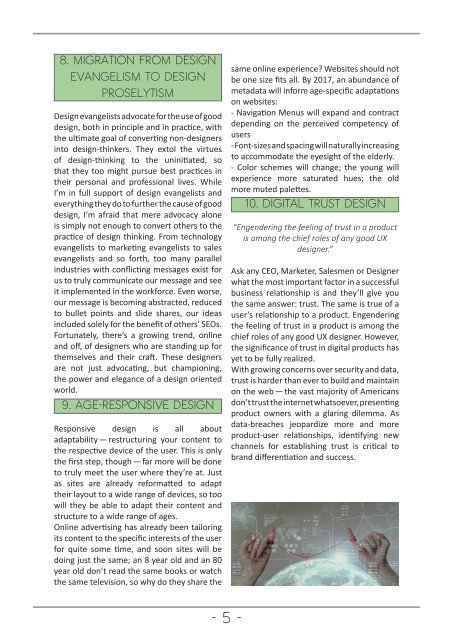Luke Priest Magazine
You also want an ePaper? Increase the reach of your titles
YUMPU automatically turns print PDFs into web optimized ePapers that Google loves.
8. migration from design<br />
evangelism to design<br />
proselytism<br />
Design evangelists advocate for the use of good<br />
design, both in principle and in practice, with<br />
the ultimate goal of converting non-designers<br />
into design-thinkers. They extol the virtues<br />
of design-thinking to the uninitiated, so<br />
that they too might pursue best practices in<br />
their personal and professional lives. While<br />
I’m in full support of design evangelists and<br />
everything they do to further the cause of good<br />
design, I’m afraid that mere advocacy alone<br />
is simply not enough to convert others to the<br />
practice of design thinking. From technology<br />
evangelists to marketing evangelists to sales<br />
evangelists and so forth, too many parallel<br />
industries with conflicting messages exist for<br />
us to truly communicate our message and see<br />
it implemented in the workforce. Even worse,<br />
our message is becoming abstracted, reduced<br />
to bullet points and slide shares, our ideas<br />
included solely for the benefit of others’ SEOs.<br />
Fortunately, there’s a growing trend, online<br />
and off, of designers who are standing up for<br />
themselves and their craft. These designers<br />
are not just advocating, but championing,<br />
the power and elegance of a design oriented<br />
world.<br />
9. age-responsive design<br />
Responsive design is all about<br />
adaptability — restructuring your content to<br />
the respective device of the user. This is only<br />
the first step, though — far more will be done<br />
to truly meet the user where they’re at. Just<br />
as sites are already reformatted to adapt<br />
their layout to a wide range of devices, so too<br />
will they be able to adapt their content and<br />
structure to a wide range of ages.<br />
Online advertising has already been tailoring<br />
its content to the specific interests of the user<br />
for quite some time, and soon sites will be<br />
doing just the same; an 8 year old and an 80<br />
year old don’t read the same books or watch<br />
the same television, so why do they share the<br />
same online experience? Websites should not<br />
be one size fits all. By 2017, an abundance of<br />
metadata will inform age-specific adaptations<br />
on websites:<br />
- Navigation Menus will expand and contract<br />
depending on the perceived competency of<br />
users<br />
- Font-sizes and spacing will naturally increasing<br />
to accommodate the eyesight of the elderly.<br />
- Color schemes will change; the young will<br />
experience more saturated hues; the old<br />
more muted palettes.<br />
10. digital trust design<br />
“Engendering the feeling of trust in a product<br />
is among the chief roles of any good UX<br />
designer.”<br />
Ask any CEO, Marketer, Salesmen or Designer<br />
what the most important factor in a successful<br />
business relationship is and they’ll give you<br />
the same answer: trust. The same is true of a<br />
user’s relationship to a product. Engendering<br />
the feeling of trust in a product is among the<br />
chief roles of any good UX designer. However,<br />
the significance of trust in digital products has<br />
yet to be fully realized.<br />
With growing concerns over security and data,<br />
trust is harder than ever to build and maintain<br />
on the web — the vast majority of Americans<br />
don’t trust the internet whatsoever, presenting<br />
product owners with a glaring dilemma. As<br />
data-breaches jeopardize more and more<br />
product-user relationships, identifying new<br />
channels for establishing trust is critical to<br />
brand differentiation and success.<br />
- 5 -<br />
<strong>Magazine</strong>.indd 6 09/01/2017 10:33:28


